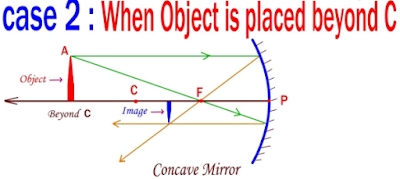 |
SPHERICAL MIRRORSA spherical mirror is a part of a hollow sphere whose one side is reflecting and other side is opaque. |
The spherical mirrors are of two types viz concave mirror and convex mirror.
(a) Concave mirror.
The spherical mirror whose reflecting surface is towards the centre C of the sphere of which the mirror forms a part is called concave mirror.
(b) Convex mirror.
In a convex mirror, the reflecting surface is away from the centre C of the sphere of which the mirror forms a part
Some Definitions of the basic features of a concave mirror and a convex mirror.
(1) Centre of Curvature.
It is the centre C of the sphere of which the mirror forms a part .
(2) Radius of Curvature.
It is the radius R of the sphere of which the mirror forms a part.
(3) Pole.
The centre of the spherical mirror is called its pole P.
(4) Principal axis.
It is the line joining the pole and centre of curvature of the mirror.
(5) Aperture.
The diameter of the mirror is called the aperture of the mirror.
The line joining the points A and B represents the aperture of the mirror.
(6) Principal focus.
When rays of light are incident parallel to principal axis then reflected rays lines passes through a fixed point on principal axis. This point is called principal focus.
Or
The point on principal axis through which incident ray lines passes and become parallel after reflection is called principal focus.
Note.
In a concave mirror, all the rays parallel to the principal axis converge to focus F after reflection .For this reason, a concave mirror is known as a converging mirror.
In case of a convex, mirror, all the rays parallel to the principal axis are reflected by the mirror so that they appear to come from focus F behind the mirror. The reflected rays appear to diverge from F .For this reason, a convex mirror is called a diverging mirror.
(7) Focal length.
The distance of principal focus F from the pole P of the spherical mirror is called focal length (f) of the mirror.
PF = f.
PF = f.
IMPORTANT RAY PATHS
there are three rays that are particularly useful in locating the corresponding image point.
(i) When a ray is incident parallel to the principal axis then reflected ray line passes through the focus F.
For concave mirror:
When object is at infinity ( long distance from mirror):
 |
Nature of image At focus, Point image, real and inverted |
For convex mirror:
When object is at infinity ( long distance from mirror):
Object is at finite distance from mirror
 |
Nature of image Point image, virtual and erect |
 |
Nature of image Diminished, virtual, erect and between pole and focus |
NEW CARTESIAN SIGN ONVENTION
While dealing with reflection at spherical mirror, the following sign convention called New Cartesian Sign Convention is followed :
(i) All distances are measured from the pole of the mirror.
 |
| NEW CARTESIAN SIGN ONVENTION |
(ii) The distances measured in the direction of the incident light are taken as positive while those measured in the direction opposite to the incident light are taken as negative.
(iii) Heights or distances measured upward and perpendicular to the principal axis are considered positive while those measured downwards are considered negative.
According to this sign convention, the focal length (f) and radius of curvature (R) are negative for a concave mirror and positive for a convex mirror.
RELATION BETWEENS f AND R
f = R/2
,for a concave mirror as well as for a convex mirror.
,for a concave mirror as well as for a convex mirror.
MIRROR FORMULA
There is following simple relation between the distance u of the object from the mirror, the distance v of the image from the mirror and focal length f of the mirror :
There is following simple relation between the distance u of the object from the mirror, the distance v of the image from the mirror and focal length f of the mirror :
this is known as mirror formula and is valid for both concave and convex mirrors, whether the image formed is real or virtual However, the quantities must be substituted with proper signs.
Uses of concave mirrors
(i) A concave mirror is used as shaving or make-up mirror. It is because when the person keeps the face between the pole and focus of the concave mirror, a magnified and erect image of the face is formed.
(ii) A concave mirror is used by dental surgeons as inspection mirror to view the dental cavities.
(iii) A concave mirror is used as a reflector in headlights of cars, railway engines, search light etc. The source of light is placed at the focus of the concave mirror. The light rays after reflection travel over a large distance as a parallel intense beam.
(iv) A small concave mirror with a small hole at its centre is used in the doctor's ophthalmoscope. The concave mirror reflects the light on the retina of the patient. This makes the retina quite visible.
Uses of Convex mirrors
(i) A convex mirror is used as a driver's mirror in scooters, cars and other vehicles. The convex mirror produces virtual, erect and diminished images of the objects behind the vehicles. Therefore, the driver has a large field of view as compared to a plane mirror or concave mirror.
(ii) A convex mirror is used as a reflector in street lamps.
(iii) A convex mirror is used in anti-shoplifting devices.
Related Article ( Click to read )
















No comments:
Post a Comment